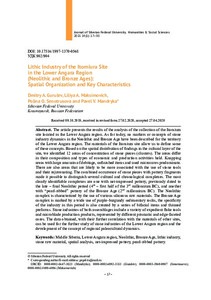Lithic Industry of the Itomiura Site in the Lower Angara Region (Neolithic and Bronze Ages): Spatial Organization and Key Characteristics
Скачать файл:
URI (для ссылок/цитирований):
https://elib.sfu-kras.ru/handle/2311/135333Автор:
Gurulev, Dmitry A.
Maksimovich, Liliya A.
Senotrusova, Polina O.
Mandryka, Pavel V.
Гурулёв, Д.А.
Максимович, Л.А.
Сенотрусова, П.О.
Мандрыка, П.В.
Дата:
2021-01Журнал:
Журнал Сибирского федерального университета. Гуманитарные науки. Journal of Siberian Federal University. Humanities & Social Sciences; 2021 14 (1)Аннотация:
The article presents the results of the analysis of the collection of the Itomiura site located in the Lower Angara region. As for today, no markers or concepts of stone industry dynamics in the Neolithic and Bronze Age have been described for the territory of the Lower Angara region. The materials of the Itomiura site allow us to define some of these concepts. Based on the spatial distribution of findings in the cultural layer of the site, we identified 12 areas of concentration of stone pieces (clusters). The areas differ in their composition and types of economic and production activities held. Knapping areas with large amounts of debitage, unfinished items and used microcores predominate. There are also areas that are likely to be more associated with the use of stone tools and their rejuvenating. The combined occurrence of stone pieces with pottery fragments made it possible to distinguish several cultural and chronological complexes. The most clearly identifiable complexes are one with net-impressed pottery, previously dated to the late – final Neolithic period (4th – first half of the 3rd millennium BC), and another with “pearl-ribbed” pottery of the Bronze Age (2nd millennium BC). The Neolithic complex is characterized by the use of various siliceous raw materials. The Bronze Age complex is marked by a wide use of purple-burgundy sedimentary rocks, the specificity of the industry in this period is also created by a series of bifacial items and thinned preforms. Stone industries of both assemblages include a variety of expedient flake tools and microblade production products, represented by different prismatic and edge-faceted cores. The data obtained, with their further correlation with the materials of other sites, can be used for the further study of stone industries of the Lower Angara region and the development of the concept of regional paleocultural dynamics В работе представлены результаты анализа каменной индустрии
стоянки Итомиура, расположенной в Нижнем Приангарье. На основании
пространственного распределения находок в культурном слое памятника
выделено 12 участков концентрации изделий из камня (скоплений). Выделенные
площадки различаются по составу и видам происходившей на них хозяйственно-
производственной деятельности. Преобладают площадки, включающие большое
количество продуктов расщепления, незаконченные изделия и сработанные
нуклеусы. Также отмечены площадки, формирование которых, вероятно, в большей
степени связано с использованием каменных орудий и их подправкой. Совместное
залегание каменных изделий с фрагментами керамической посуды позволяет
рассматривать их как отдельные культурно-хронологические комплексы. Наиболее
выразительны комплексы с «сетчатой» керамикой, предварительно датированной
поздним – финальным неолитом (IV – перв. пол. III тыс. до н. э.), и с «жемчужно-
рубчатой» посудой бронзового века (II тыс. до н. э.). Для неолитического комплекса
характерно использование разнообразного кремнистого сырья. В комплексе
бронзового века отмечено широкое использование фиолетово-бордовых осадочных
пород, специфику индустрии также формирует серия бифасиальных форм и
изделий с оббивкой утончения. Для каменных индустрий обоих комплексов
характерны разнообразные неформальные орудия и продукты микропластинчатого
производства, представленные различными призматическими и торцовыми
нуклеусами. Полученные данные, при их корреляции с материалами других
памятников, актуальны для дальнейшего изучения каменных индустрий голоцена
Нижнего Приангарья и разработки концепции региональной палеокультурной
динамики

